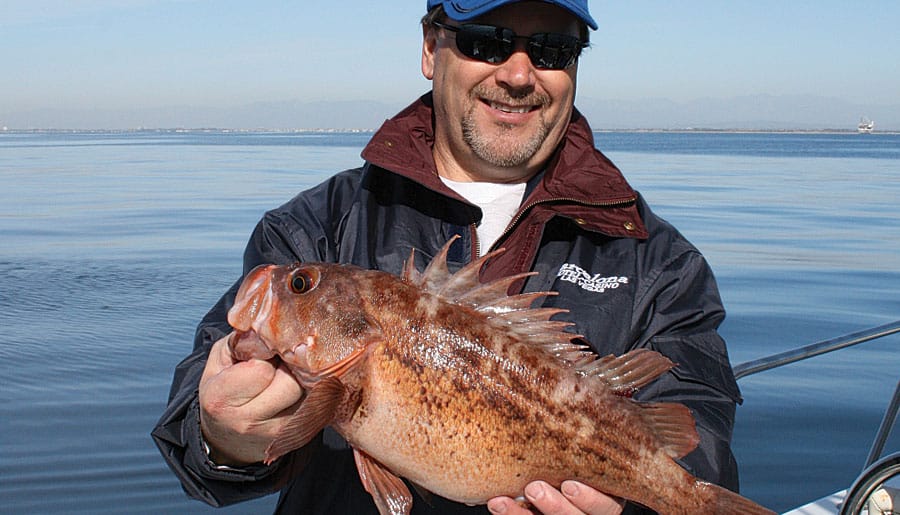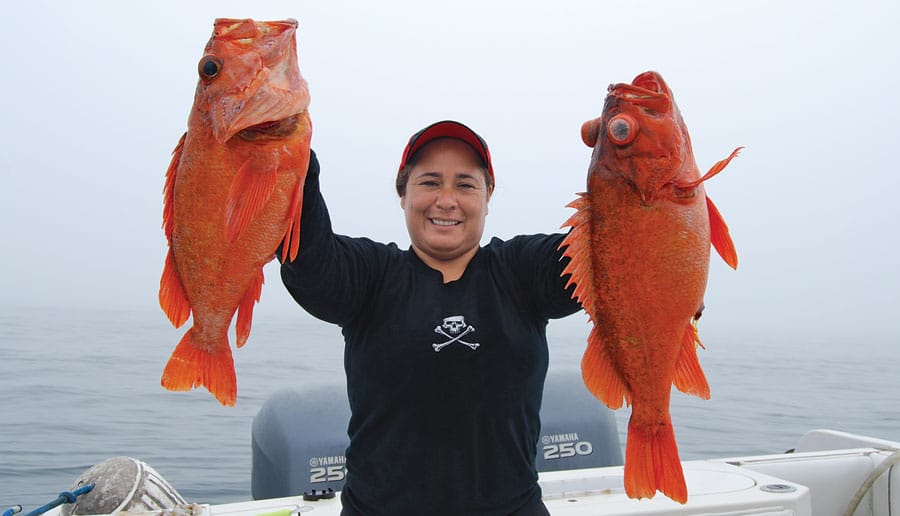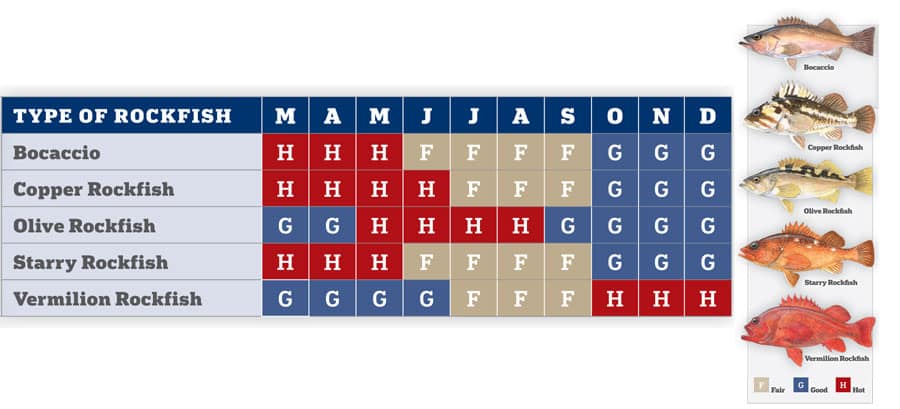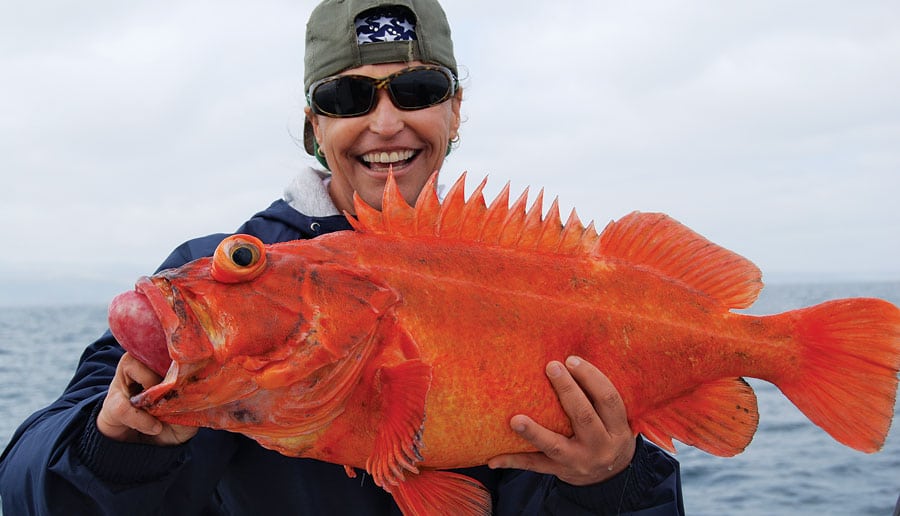
Complicated restrictions on rockfish have become a fact of life for Southern California ocean anglers, but that has not stopped them from pursuing the numerous, colorful and tasty species that inhabit these coastal waters. Make sure you are up to date on the latest seasons and regulations before fishing for rockfish. While out there, you never know which of the 57 species listed by the California Department of Fish and Game you might hook. Plus, you might catch lingcod, California sheephead or ocean whitefish.

How to Catch Rockfish Near Structure
No matter what the species, the key to rockfishing is structure, particularly rocks. Species such as vermilion rockfish, copper rockfish, starry rockfish, flag rockfish, bocaccio and chilipepper are all structure-oriented and usually dwell very close to the bottom, though some species, such as olive and blue rockfish, will suspend over structure.
Low-relief hard bottom areas can be just as productive as rocky, snag-infested spots. This is particularly true around offshore islands like Anacapa, Santa Barbara, Santa Catalina, San Clemente, Santa Cruz, San Miguel, San Nicolas and Santa Rosa.
“I like to fish broad, relatively low-structure areas,” says Santa Barbara-based Capt. David Bacon, whose WaveWalker Charters targets the Channel Islands, as well as the coasts of Ventura and Santa Barbara counties — a region he calls the epicenter of rockfishing.
Whether you’re fishing the islands or coastal areas, the larger the structure area is, the longer the drift and the more time you have to fish productive bottom, Bacon points out. That’s a great rockfishing tip that Bacon points out, but also understand smaller structure spots can produce fish. Smaller structures are tougher to stay over the fish in typical rockfish depths of 120 to 360 feet, especially if there’s wind or current.
Picking the Best Depths for Rockfish Fishing
Which depths Bacon fishes for rockfish depends on two factors. One is the experience level of his crew, and the other is the amount of fishing pressure an area receives.
“With kids and novice anglers, the maximum depth is about 150 feet,” he says. “That allows the guests to have a better feel for hooking fish. At the same time, the fish tend to be a bit smaller than those you find at greater depths.
“With more experienced anglers, we’re rockfishing 250 feet or more, where you get bigger rockfish,” Bacon explains. Maximum legal depth for catching rockfish is generally 360 feet, but in places such as Cowcod Conservation Areas, the maximum depth is 120 feet, and the number of species you can take is limited.
Bacon has found that the outer islands, such as Santa Rosa and San Miguel, receive less rockfishing pressure, so you don’t have to fish as deep. He sometimes has great success on rockfish in water as shallow as 60 feet. Getting out to these islands, however, is not always possible due to strong winds, particularly in spring.

Boat Handling Rockfishing Tips
When you’re rockfishing in deeper water, anchoring is not usually practical. Drifting over productive structure is the traditional method for targeting these fish.
“Many boating anglers motor up to the structure spot, and once they see the rocky area on their fish finder, they stop and drift fish,” says Bacon. “But this is not the most productive method.”
Bacon points out that rockfish tend to congregate on one particular side of a structure zone, so you should use the fish finder to locate the concentration, which is often on the up-current side of the rocks.
“Once I have zeroed in on fish, I find it productive to use a method I call motor anchoring,” he says.
It’s a simple rockfishing tip. Bacon remains at the helm and uses the throttles of his twin outboards to keep the boat positioned over productive bottom while his guests’ fish.
Not only does this allow anglers to fish in the strike zone longer, but it helps keep fishing lines as vertical as possible. This enables better bite detection and reduces the chance of lines snagging the bottom, which is more likely when they are streaming behind a drifting boat. However, you have to be careful to avoid tangling fishing lines in the propellers.
On small, deep structure spots, this technique is especially useful, but it is important that crew members are ready to drop on the captain’s command, says Bacon. “The anglers need to be ready with rockfish bait, standing at the rail and ready to fish when I say drop. On a small spot, if you don’t get the bait to the bottom immediately, you might as well wait till the next go around, because you will have missed the fish.”

California Rockfishing Rig Setup
Thin-diameter braid is a boon to rockfishing, boosting sensitivity, hookups and the ability to keep fish out of the rocks in deep water. Bacon recommends a medium-size conventional reel, such as a Penn International 975 lever-drag or Shimano Torium 20, filled with 50-pound coated braid. He likes a 7- to 8-foot medium-action rod, like a Calstar 870H or Bluewater Carnage 800M.
For terminal tackle, Bacon pre-ties a number of 4-foot-long twin dropper-loop leaders using 30-pound monofilament. You are legally allowed to fish with two hooks per leader in California. Bacon likes 10-inch-long loops with a free-sliding hook to give rockfish a better opportunity to inhale the bait. A barrel swivel links the leader to the main line, and a torpedo swivel is tied to the bottom.
The weight of the sinker depends on the water depth, but if you can successfully motor-anchor, you can keep the weight to a minimum and still maintain contact with the bottom, says Bacon, who carries a selection of sinkers ranging from 3 to 20 ounces.
Hook size depends on the bait. Some of the best bait for rockfish is live sardines and anchovies. Bacon matches the hook to the rockfish bait using a selection ranging from No. 2 to 2/0. For 3-inch squid strips, which stay on the hook well, 2/0 to 3/0 hooks work well. Some of the best rockfish lures are Berkley Gulp! baits, such as shrimp imitations or curly-tail grubs. For those soft baits, use 1/0 to 2/0 hooks. Bacon says that the best Gulp! colors are Pink Shine for shrimp and Nuclear Chicken for grubs.
Jigging for Rockfish
Another terminal rig that Bacon likes is a single-loop leader with a hook about two feet above a metal jig at the bottom of the leader. Jigs such as a Salas 6X or 6X Jr. or Tady 4/0 or C with treble hooks work well. Bouncing the jig close to the bottom often attracts larger rockfish and lingcod. Hues of red and brownish patterns like Scrambled Egg work best, says Bacon.
California Rockfishing Tip
To ensure the area you’re planning to fish is open, go to wildlife.ca.gov/Conservation/Marine/MPAs for details on these fishing closures and maps of the areas. Once you have determined that it’s legal to fish, use a chart plotter and fish finder to locate rocky and hard bottom areas and wrecks along the coastal areas and offshore islands.
What types of Species: Rockfish, as well as lingcod and ocean whitefish.
When to Catch Rockfish: March through December (seasonal closure in January and February).
Where to Catch Rockfish: Santa Barbara, Ventura, Los Angeles, Orange and San Diego county coasts, and offshore islands.
Tackle to Use for Rockfishing
Rockfishing Rods: Medium-action 7- to 8-foot rods.
Rockfishing Reels: Medium conventional and saltwater bait-casting reels.
Rockfishing Lines: 50-pound-test coated braid for main line; 30-pound-test monofilament for leader.
Rockfishing Baits and Lures: 3-inch squid strips, live sardines, live anchovies, Berkley Gulp! Shrimp and Gulp! Grubs, and metal jigs like Salas 6X and 6X Jr. and Tady 4/0 and C models.
California Rockfishing Charter Captains
Capt. David Bacon
WaveWalker Charters
805-895-3273
Capt. Mark Wisch
Pacific Edge Charters
800-339-3922
www.pacificedgetackle.com
Capt. Dave Hansen
Hansen’s Guide Service
949-374-0786
www.yoursaltwaterguide.com









